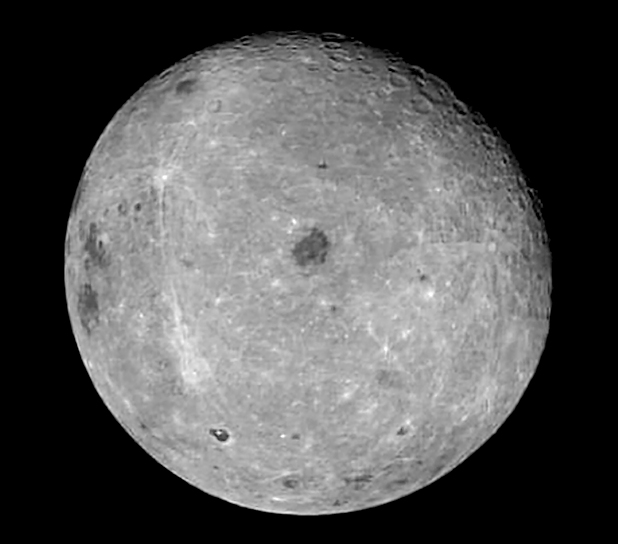
image from Nozomi spacecraft and provided by Ted Stryk
Most spacecraft images of the Moon come from a handful of spacecraft programs: Ranger, Orbiter, Surveyor, Apollo and Clementine on the American side, and Luna (47 of them including two with Lunokhods) and Zond from the Soviets. But a variety of other spacecraft snapped a few tourist images while heading eleswhere in the solar system, including Galileo, Cassini and Stardust. This image is from Nozomi, which was designed as a Mars orbiter but ended up a hard luck mission with only a few lunar snapshots. Nozomi was launched July 3, 1998 and flew past the Moon twice, obtaining this image in September. Perhaps Nozomi’s greatest claim to fame is that this is the best Full Moon image of the farside obtained so far. The first Galileo flyby mosaic is higher resolution but shows only about 50% of the farside. This image includes only a sliver of the nearside - notice Marginis, Smythii and Humboldtianum near the left limb. The farside at full is pretty boring compared to the patterns of maria on the nearside. The farside looks like a miniature Starwars Death Star with a single, baleful eye (Mare Moscoviense) near its center, at least in this view. It is interesting that the South Pole-Aitken Basin does not look as dark as it did in Luna 3and most other lower Sun views. North of Tsiolkovskiy (the dark floored crater with a bright central peak) is probably the largest feature whose name has been removed from the Moon. The elongated bright area was named the Soviet Mountains by the proud team that successfully flew Luna 3, but it is really a complex crater ray pattern. Like the Soviet Union, the Soviet Mountains are no more. Nozomi was plagued with bad luck - a rocket firing was too short and a solar storm damaged its electronics, so that it finally flew past Mars without being able to take a single image.
Technical Details:
Sept 24, 1998. Mars Imaging Camera JAXA/ISIS. The image was JPEG compressed onboard the spacecraft. Ted thanks Ai Inada, one of the MIC team members, for providing him the data
Related links:
Nozomi
I will be leaving for the Lunar & Planetary Science Conference on Sunday and may not be able to produce new LPODs for 4-6 days. Lets see what happens.
COMMENTS?
Click on this icon File:PostIcon.jpg at the upper right to post a comment.



